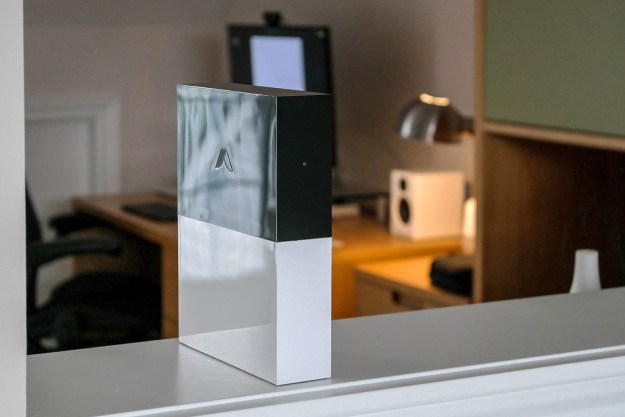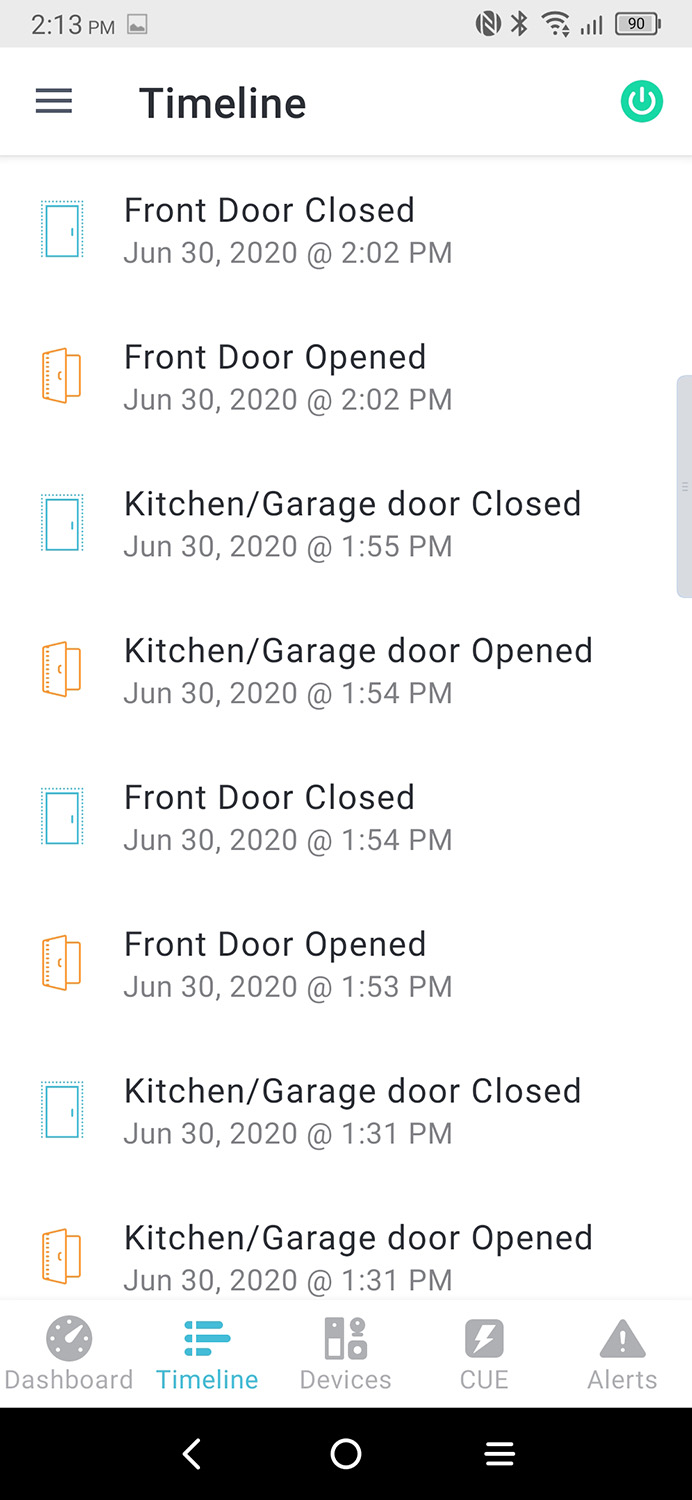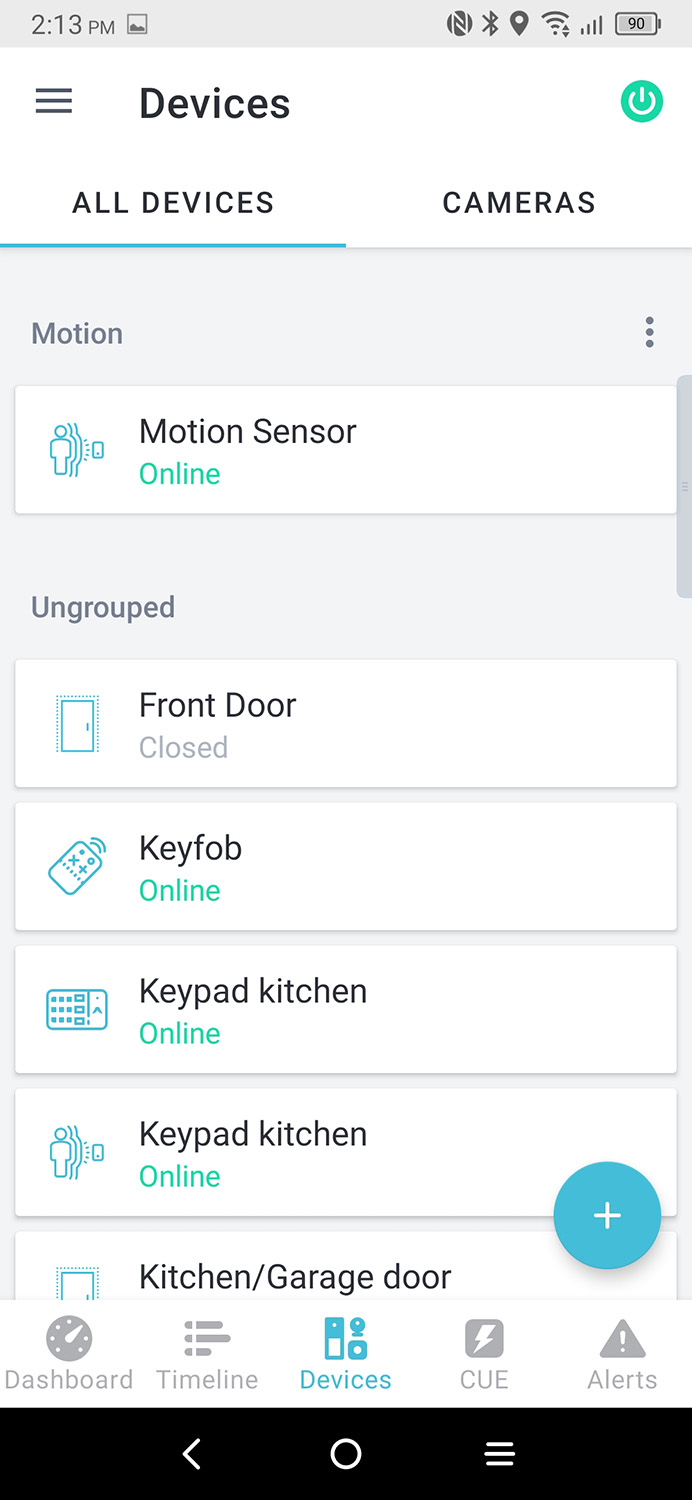
“The basic, low-spec hardware disappoints, but with a smooth app experience, Abode is a smart home platform that shouldn’t be ignored.”
- Beautifully designed web and app dashboard controls
- Z-Wave, Zigbee, Wi-Fi and Abode RF connectivity
- Support for more than 200 device integrations
- Voice control via Amazon Alexa or Google Assistant
- Cheap, relatively flimsy hardware
- Low resolution camera with blurry, smeared images
- Patchy sensor connectivity
There’s been a resurgence in smart home security solutions this year, with August, Nest, Ring, and Samsung SmartThings all announcing lines. Of course, companies like Abode are old hands at smart security, selling gateways, sensors, remote keyfobs, and motion-sensing cameras following a successful Kickstarter launch.
With Abode introducing a 1080p security camera, door sensors, and a swathe of third-party device integrations and compatibility with Google Assistant and Amazon Alexa, we thought it would be a great time to take a look at the company’s $199 Starter Kit (originally $299). Find out how it fared in our Abode Starter Kit review below.
The full Abode hardware range encompasses an exhaustive array of hardware, including a gateway alarm system, door and window sensors, motion and occupancy detectors, security cameras, power outlets, smoke alarms, temperature sensors, and a whole lot more. The Abode Starter Kit is designed to introduce you to the ecosystem with a neat, entry-level package that won’t break the bank.
It includes the Abode Gateway, a reasonably compact hub, that serves as the heart of the security network, incorporating a 93-decibel siren to scare even the bravest intruders away. Accompanying the Gateway are two door/window contact sensors, a motion camera, and a remote key fob for arming or disabling the system with a simple button push.
No Humble Abode
The Abode Starter Kit arrives attractively packaged in a buff and cyan carton that proclaims itself to be “The Future of Home Security.” On first glance, it’s certainly no humble Abode. The hardware itself is relatively well built but doesn’t quite nail the premium feel you experience with products from Nest or August. The stark, modernist aesthetics of the black and white Abode Gateway will split opinion. We aren’t huge fans of the looks of the device, which resembles a basic, rectangular router from 2011 — thankfully without the antennas, though. We were concerned with the skin-scraping sharp edges and pointy corners on the device. Clad in shiny acrylics that pick up fingerprints, smudges, and smears with ease, the Abode Gateway may look (and literally feel) sharp, but it also feels a little cheap.
The remaining hardware included in the Starter Kit ranges in build quality. The door/window sensors feel similarly flimsy, but the motion camera and two-tone key fob are more robust, with the latter feeling good in the hand.
Multiple radios connect a wide ecosystem of security devices, with optional monitoring services
Perhaps the more significant share of the build cost has been invested under the hood. With integrated Wi-Fi, Z-Wave, Zigbee, and AbodeRF (the latter a proprietary protocol for long-range connectivity), the Abode Gateway connects to an expansive array of sensors, smart power outlets, and controllers. Up to 155 devices can be connected, and with Google Assistant and Amazon Alexa now integrated, you can control some of your devices with your voice. You can also enable the Alexa Guard skill to arm and disarm the system.
It’s good to see a range of options available and the plans themselves are easy to understand
Several third-party devices also work with Abode, including Nest Cam, Nest Protect and the Nest Learning Thermostat, Philips Hue, Amazon Echo, and IFTTT. Alongside the company’s own devices, the gateway plays nicely with hardware from Aeon, Enerwave, Fibaro, GE, Kwikset, Leviton, Schlage, and others.
Alongside that powerful 93-decibel siren, the Abode Gateway features a 10-hour battery backup that maintains protection in case of a power outage and an optional cellular network connection available for a $10 monthly fee.
Abode is billed as a professional security system, so it makes sense that the company also offers 24/7 professional monitoring, bundled with cellular service backup at $30 per month. This Connect + Secure plan also includes a 90-day timeline and media storage, compared to just three days of storage available from the basic starter kit. You can decide whether professional monitoring is something that your home needs, but it’s good to see a range of options available, and the plans themselves are easy to understand with no fixed-term lock-ins.
Smooth system installation, with one minor hiccup
As you’d expect, installing a reasonably comprehensive security system in the home isn’t a two-minute job, but Abode is clearly striving to make the process as painless as possible. The Gateway connects to your wireless router via a spare Ethernet port, and a quick button slide on the rear of the device activates its backup battery.
From there, you can configure the Gateway using the free Abode app, available for iOS and Android devices. You’ll need to create an Abode account, then choose to continue setup on your mobile device or desktop web browser.

An activation code supplied in the box identifies your gateway and is required to connect the starter kit with your account. Once entered, your Abode Gateway is quickly located on the Internet and activated. It’s quick and easy.
Of course, you’ll then have the fun of installing the sensors and camera around the home. Thankfully, the Abode app guides you through device installation with handy tips on sensor placement and alignment. Depending on the size of your doors, windows, and frames, you may find the sensors to be more than a little chunky — while adding security, they certainly won’t improve aesthetics. But at least they’re easy to install, with double-sided adhesive strips ensuring there are no tools required.
Abode is clearly striving to make the installation process as painless as possible.
The installation guidance for the motion camera was less successful. First, we were asked to remove a clear plastic tab to activate the batteries but couldn’t find the tab on the device. It was then that we noticed that the batteries were in the box and hadn’t been installed. No drama, but a little sloppy from a user experience perspective. Installing the batteries was a quick job, but required a screwdriver to take off the camera’s rear plate.
Once powered, you can try out various locations for the motion camera, which snaps still images when its integrated PIR sensor is triggered. Preview the resulting images and you’re done.
A rear bracket snaps into the device for corner mounting, with adhesive strips sticking to each wall to firmly hold the camera in place. Alternatively, you can apply a different self-adhesive pad, supplied in-box, for flat wall installation. While the sticky pads are certainly convenient and do a good job of holding the equipment in place, we would like to see wall anchors and screws also supplied as a more permanent option. Renters, beware! The pads will pull away paint from the wall when removed. A stand for the camera, which would allow more freedom in positioning as well as easy relocation, would also be a great addition.
With the hardware set up, the Abode app allows you to grant account access to family and friends. Just two user accounts are supported in the basic free plan, but if you pony up for one of Abode’s monthly services, that restriction is lifted. A quick tour of the app and you’re up and running. Expect to spend at least 15 minutes setting up Abode, with trickier camera positions requiring more time. But aside from that camera battery mistake, the Abode system installation was a breeze.
Simple and responsive, but low-specification hardware dilutes the experience
One aspect of life with Abode that we really liked was that you’re not restricted to monitoring the system via a mobile app. Log into the Abode website via a desktop browser, and you have full visibility and control of your home security. The system combines the convenience of mobile app control with the comfort of desktop monitoring — a perfect combination.
When Abode first shipped its all-inclusive security package, it included an app for Android that was, to put it nicely, a first effort. Since then, Abode has updated to version 5.0.4 and it is miles better than the previous version. When you first open the app, you are asked for a PIN. You can also tie in your phone’s fingerprint reader to bypass the lock.
Once you get into the app, the Dashboard gives you access to your system status, plus quick actions and Camera views. Quick Actions allow you to create shortcuts to common tasks that prevent you from having to dig through menus.
Across the bottom navigation bar, you’ll find what’s most important to the system. The timeline shows you all events that have occurred. CUE is an automation feature we discussed at length before. Your list of devices shows you what you have and what their statuses are, and they’re all just a tap away. Even the general app settings have been organized in a much better interface. The first edition of this app had most of what this version does, but the key difference here is they’re in places that make sense. To put it delicately, the last iteration of the app didn’t quite reach that bar.
Overall, this is a major update to the software that runs your smart home security, and it was very badly needed. The former app relied heavily on using the in-browser interface while referencing on mobile. You can still use the web interface, but there’s much less reliance on it now. This app puts a lot more control onto your phone, which is the device most of us will turn to the most anyway. It’s a major facelift for the app and for the company as a whole.
Access Abode through a desktop browser and you benefit from an extended array of features, beautifully presented in a modern, web-based dashboard. Again, you can view a neat timeline of events and alerts, monitor, and manage device status and settings, create quick actions (think of these like macros for multiple devices), configure automatic home and away perimeters to arm or disarm the system based on your smartphone location, and much more.
The Gateway alarm was quick to trigger via the camera and was piercingly loud.
On the downside, you will have to deal with repeated attempts to persuade you to buy additional hardware or subscribe to one of the company’s premium service plans. You can’t blame Abode for trying to build a business, but once the plans are rejected at startup, those prompts really need to go away rather than continually popping up. Overall, Abode supports a strong array of monitoring and management features, which are well presented and highly responsive across both mobile and desktop dashboards.
The Starter Kit hardware itself is a little less slick. Images snapped by the motion camera are very low resolution (320 x 240 by default, rising to 640 x 480 maximum) leading to the kind of blurry, smeary shots that can certainly be used to detect presence, but aren’t great for identification. With no night vision support, the camera relies on an integrated flash for images in the dark. The flash does a decent job of illuminating a dark room, although the images are a little yellow. However, it’s the low resolution that’s the major issue – you’ll certainly want to consider upgrading to Abode’s newly announced $149 1080p indoor camera, which offers live streaming video, triggered recording and integrated night vision.
We also found the window/door sensors to be a little temperamental. While the system correctly detected a door or window being opened, it was far less successful in detecting the same door or window being closed once again. That led to complaints when we tried to arm the system, with Abode repeatedly and incorrectly telling us that the door was open. Perhaps with more time to fine-tune the positioning of the sensors, we could improve detection in both directions, but we were frustrated that detection worked one way, but not the other.
We had no complaints about the Gateway alarm, which was triggered by the camera or door window/sensor and was piercingly loud. Once triggered, we received an alert on the phone within seconds with convenient options for notifying the police or disabling the alarm. The system responded quickly when we disabled the alarm, and the racket ceased in just a couple of seconds.
Overall, we were pleased with Abode’s simplicity and responsiveness but, like any multi-device system, your experience will be governed somewhat by the smart home sensors and other hardware you choose to connect. As such, the Abode Starter Kit certainly gets you up and running with the basics, but it won’t be long before you’re seeking to upgrade.
Add Alexa and other smart home devices for perfect partnerships
Of course, you can’t launch a smart home system nowadays without getting friendly with a slew of third-party devices. With Google (via Nest) and Amazon both getting into the smart home security game, startups like Abode need to deliver breadth, depth, and quality when it comes to integration. On first glance, Abode appears to have hit the ground running.
Abode’s Alexa skill allows you to monitor and control the system using an Amazon Echo or other Alexa-powered device. In case you’re concerned about security, a verbal PIN number is used to confirm certain commands, such as disarming the system or disabling an alarm. Alongside core features such as the Gateway alarm, the skill supports a broad selection of commands, controlling connected locks, outlets, garage doors, and configured quick actions.
We found Alexa integration to work well. If you detect an intrusion, you can verbally trigger (or disable) a panic alarm far quicker than fumbling for your phone. Arming the system by voice command takes a just couple of seconds, and we found Abode to be very responsive throughout.
We hooked in a Nest Learning Thermostat and were pleased to see not only that you could sync Abode’s Away status with that of the thermostat, but manual temperature control was also available from the Abode desktop dashboard and mobile app. This is no quick and dirty implementation, either. On both dashboards, clear thought has been applied to creating a simple, intuitive user interface that neatly bridges Abode’s overall design with the device being controlled.
With a strong and flexible platform at its foundation, Abode shouldn’t be ignored.
Abode has developed a strong and flexible platform that could easily serve as the control panel for many a smart home.
While the Abode Starter Kit isn’t perfect, it certainly offers a convenient introduction to the company’s smart home platform at a reasonable price. Considering its Kickstarter roots, it’s no surprise that the Gateway hardware and sensors are a little rough around the edges (sometimes literally), and we’d like to see second-generation devices from Abode deliver a more premium feel with higher specifications and greater reliability. The camera and sensors included in the Starter Kit don’t show off the Abode ecosystem as well as they really should, and while the Gateway works well, it won’t be the prettiest nor well-built device in your home.
But look beyond these entry-level devices and you can see that there’s been significant investment in Abode’s underlying platform. The Abode app and web dashboard are well designed and beautifully executed, supporting simple, intuitive control without trying to be unnecessarily flashy. The third-party integrations we tested were easy to connect and worked well, demonstrating Abode’s potential as a comprehensive smart home solution that connects heating, lighting, entertainment, and security.
With huge corporations now dominating the smart home market, Abode will certainly need to work on its hardware to continue early momentum. But with a strong and flexible platform at its foundation, Abode shouldn’t be ignored.
Warranty information
The Abode Starter Kit is supported by a one-year limited warranty that covers defects in materials or workmanship.
Our Take
The Abode Starter Kit offers a reasonably priced introduction to the company’s smart home platform, but the included Gateway, Camera, and Sensors offer disappointing build quality and specifications. However, Abode’s software platform is simple, intuitive, and connects to a slew of smart home devices. Abode may not top our list of smart home platform providers, but it’s certainly one to watch.
Is there a better alternative?
Before jumping in with a smart home security purchase, hold on for the more premium — and pricey — $499 Nest Secure system or the more affordable $199 Ring Alarm.
How long will it last?
Four years in and Abode is doing a sterling job of adding new features and upgrades to their platform. As a small business with installations in the thousands rather than hundreds of thousands, time will tell whether the company can take on the might of Nest, Amazon, and other tech giants. Smart Home security is undergoing a resurgence, and there’s likely to be casualties. So, there’s some risk in selecting a smaller provider, who may be acquired or go under in the battle for smart home supremacy. But at this point, we’re not aware of any specific issues that would suggest Abode won’t be around in the medium term.
Should you buy it?
With a host of companies announcing smart home security solutions this year, Abode wouldn’t be our first choice. The platform looks good, but the Starter Kit hardware is decidedly Kickstarter-class. Be sure to check out larger competitors like Nest, Amazon, and Netgear, before jumping in.
Updated July 13, 2020: Noted the updated app experience.
Editors' Recommendations
- How to save Ring Doorbell video without a subscription
- How to fix the most common Blink Mini 2 problems
- Best security camera deals: Ring, Arlo, Blink and more on sale
- Best Amazon Echo deals: Save on Pop, Show, Dot, and Studio
- The 6 best Echo Hub tips and tricks










